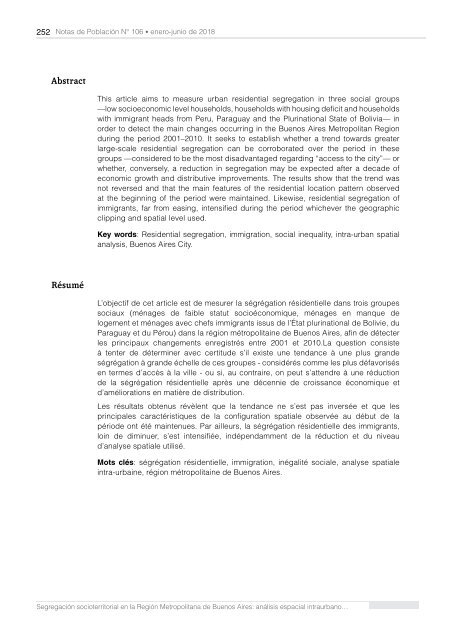Notas de Población N° 106
El número 106 de Notas de Población está conformado por 10 artículos, en cuya elaboración han participado 21 colaboradores. Los artículos abordan diversos temas de investigación relacionados con la mortalidad, el transnacionalismo migratorio y la fecundidad de las migrantes, así como la fecundidad adolescente, el femicidio, la migración de retorno, la segregación en el espacio urbano y el dividendo demográfico.
El número 106 de Notas de Población está conformado por 10 artículos, en cuya elaboración han participado 21 colaboradores. Los artículos abordan diversos temas de investigación relacionados con la mortalidad, el transnacionalismo migratorio y la fecundidad de las migrantes, así como la fecundidad adolescente, el femicidio, la migración de retorno, la segregación en el espacio urbano y el dividendo demográfico.
You also want an ePaper? Increase the reach of your titles
YUMPU automatically turns print PDFs into web optimized ePapers that Google loves.
252 <strong>Notas</strong> <strong>de</strong> <strong>Población</strong> <strong>N°</strong> <strong>106</strong> • enero-junio <strong>de</strong> 2018<br />
Abstract<br />
This article aims to measure urban resi<strong>de</strong>ntial segregation in three social groups<br />
—low socioeconomic level households, households with housing <strong>de</strong>ficit and households<br />
with immigrant heads from Peru, Paraguay and the Plurinational State of Bolivia— in<br />
or<strong>de</strong>r to <strong>de</strong>tect the main changes occurring in the Buenos Aires Metropolitan Region<br />
during the period 2001–2010. It seeks to establish whether a trend towards greater<br />
large-scale resi<strong>de</strong>ntial segregation can be corroborated over the period in these<br />
groups —consi<strong>de</strong>red to be the most disadvantaged regarding “access to the city”— or<br />
whether, conversely, a reduction in segregation may be expected after a <strong>de</strong>ca<strong>de</strong> of<br />
economic growth and distributive improvements. The results show that the trend was<br />
not reversed and that the main features of the resi<strong>de</strong>ntial location pattern observed<br />
at the beginning of the period were maintained. Likewise, resi<strong>de</strong>ntial segregation of<br />
immigrants, far from easing, intensified during the period whichever the geographic<br />
clipping and spatial level used.<br />
Key words: Resi<strong>de</strong>ntial segregation, immigration, social inequality, intra-urban spatial<br />
analysis, Buenos Aires City.<br />
Résumé<br />
L’objectif <strong>de</strong> cet article est <strong>de</strong> mesurer la ségrégation rési<strong>de</strong>ntielle dans trois groupes<br />
sociaux (ménages <strong>de</strong> faible statut socioéconomique, ménages en manque <strong>de</strong><br />
logement et ménages avec chefs immigrants issus <strong>de</strong> l’État plurinational <strong>de</strong> Bolivie, du<br />
Paraguay et du Pérou) dans la région métropolitaine <strong>de</strong> Buenos Aires, afin <strong>de</strong> détecter<br />
les principaux changements enregistrés entre 2001 et 2010.La question consiste<br />
à tenter <strong>de</strong> déterminer avec certitu<strong>de</strong> s’il existe une tendance à une plus gran<strong>de</strong><br />
ségrégation à gran<strong>de</strong> échelle <strong>de</strong> ces groupes - considérés comme les plus défavorisés<br />
en termes d’accès à la ville - ou si, au contraire, on peut s’attendre à une réduction<br />
<strong>de</strong> la ségrégation rési<strong>de</strong>ntielle après une décennie <strong>de</strong> croissance économique et<br />
d’améliorations en matière <strong>de</strong> distribution.<br />
Les résultats obtenus révèlent que la tendance ne s’est pas inversée et que les<br />
principales caractéristiques <strong>de</strong> la configuration spatiale observée au début <strong>de</strong> la<br />
pério<strong>de</strong> ont été maintenues. Par ailleurs, la ségrégation rési<strong>de</strong>ntielle <strong>de</strong>s immigrants,<br />
loin <strong>de</strong> diminuer, s’est intensifiée, indépendamment <strong>de</strong> la réduction et du niveau<br />
d’analyse spatiale utilisé.<br />
Mots clés: ségrégation rési<strong>de</strong>ntielle, immigration, inégalité sociale, analyse spatiale<br />
intra-urbaine, région métropolitaine <strong>de</strong> Buenos Aires.<br />
Segregación socioterritorial en la Región Metropolitana <strong>de</strong> Buenos Aires: análisis espacial intraurbano…


















